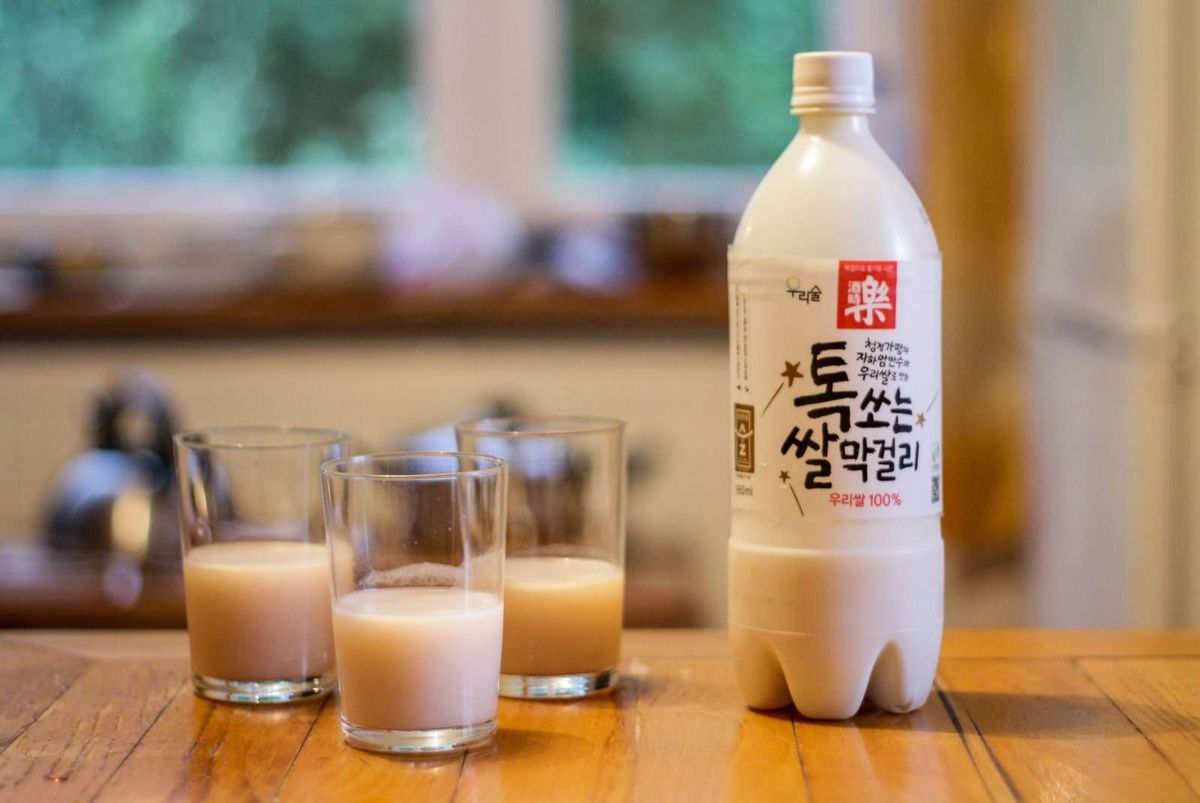Why makgeolli will be your new favorite drink

A few weekends ago, some friends and I decided to make some Korean BBQ. To be honest, I haven’t made a ton of Korean BBQ in my life, but my friends were well versed in the art, so I was handing over the cooking reigns to them (which is rare, if you ask my girlfriend). However, the one thing I did know was to do it right, a trip to H Mart was in order.
In typical form, I headed straight to the soju aisle. Sprinkled into the myriad of green soju bottles were some conspicuous-looking bottles of something called makgeolli. The bottles indicated an alcohol percentage, so naturally, I was intrigued. There were some green, plastic bottles of the stuff, but what almost immediately caught my eye was the minimalist, matted can of Màkku Makgeolli. Upon closer inspection, the bottle also solved part of the mystery, Korean rice beer. At this point, I’m even more intrigued, so we grabbed some of the blueberry and traditional flavors and headed to dinner.
What is Makgeolli?
Makgeolli sits somewhere between sparkling rice wine and beer. The fermented rice drink is packed with textures and flavors that you can’t really find in most other drinks. It’s cloudy and milky in appearance from the rice and sediment that remains, yet slightly effervescent with a touch of sweet and sour flavor. Unsurprisingly, all of these qualities pair well with the spicy and savory food of Korea.
Compared to soju, the makgeolli is an easy sipper, generally sitting around 6% alcohol. It’s also a natural probiotic packed with a weatlh of gut-friendly bacteria, proteins, dietary fibers, free amino acids, and other nutrients. Additionally, the Korean Food Research Institute found that fresh makgeolli contains 50-200 times higher squalene levels, a compound mainly found in deep-sea sharks known for its role in fighting cancer and tumor growth. So, with makgeolli, you can quite literally drink to health.
History of Makgeolli
Makgeolli (mahk-goh-lee) is the oldest alcoholic drink in Korea with an almost 2,000-year-old history. Like all good things, it started with farmers and the creativity born from necessity. Rice wine has been made for thousands of years, with the first mention of its consumption in a 13th-century Goryo Korean Book, Jewang ungi (Songs of Emporers and Kings).
Like most aspects of culture, what you drank was a symbol of your social status. Makgeolli was made by farmers using what they had plenty of, rice. And since it was cheap and the carbonation a bit refreshing, it was a popular choice to give laborers and farmers during breaks. Over time, the drink grew in popularity and became the most consumed drink in Korea.
Eventually, though, the makgeolli started to lose popularity. To understand why we need to understand the recent history of rice in Korea.
In the early 1900s, after years of war, Japan officially annexed and occupied Korea. Japan had typically sourced much of its rice production from Southeast Asia, but as French and British colonial rule made that difficult during World War I, Japan looked to Korea. Amping up production and streamlining rice cultivation (and in the process destroying over 1,000 different rice varietals), Korea went on to supply Japan with 98% of Japanese rice imports. This left Korea nearly unable to feed itself.
Things only got worse as Japan entered World War II. As makgeolli is made from rice, homebrewing was subsequently banned, and brewing was moved into factories to be taxed and become a source of income for the Japanese Empire.
Fast forward to the 1960s and post-Korean War, and Park Chung-hee was president. Amid a myriad of economic policies was the goal to make Korea rice self-sufficient. This meant the banning of rice to be used in alcohol production. Of course, people would still brew makgeolli with rice in secret. It wasn’t until the 1990s when the brew ban was lifted, and homebrewing regulations began to ease.
Throughout the late 20th century, though, Korean alcohol preferences started to change. As the country started to grow economically, beer and other imported alcohols become the desired beverage, leaving makgeolli a vestige of the old Korea. By 2002, makgeolli consumption was down to an all-time low of around 4 percent.
Fortunately, though, things are turning around for the drink. In 2010, Wolhyang, a makgeolli bar, opened up in Seoul. Since then, it’s become more fashionable as the delicious taste and the myriad of health benefits are re-discovered.
How is Makgeolli made?
Since it didn’t require any heavy equipment and distillation was likely not quite invented yet, makgeolli has a rich history of homebrewing in Korean culture.
Makgeolli is made using rice, nuruk, and water. Nuruk is a dried wheat and grain mixture that has been allowed to wild ferment and produce bacterias and microorganisms that help convert the grain to sugar and alcohol. According to Makku, the composition of the nuruk can depend on the region, so the makgeolli taste can vary from region to region. As such, the nuruk almost adds a sense of place and terroir to the drink.
After combining the rice, nuruk, and water (and potentially other flavors like fruits, nuts, or herbs) and mixed and left to ferment in a clay pot for about a week. This produces a relatively strong mixture (15 – 19% alcohol). The sediment and clear alcohol is then separated out to produce the makgeolli (with the sediment) or further distilled to make soju (with the clear alcohol).
Traditionally, makgeolli is left unpasteurized to retain the freshness and active yeasts/bacterias. When unpasteurized, the drink can continue to mature and change over time as those yeasts continue to do work, resulting in a more funky but creamier taste. The shelf life is pretty short, though, so most you’ll find at the store makgeolli has been pasteurized.
What does it taste like?
In a word, makgeolli is unique. It has a subtle sweetness with some acidity to balance it out. The fermentation gives it a slightly effervescent quality, but not as much as you’d get with a beer or sparkling wine. And the cloudy, milky appearance gives it some body and viscosity as well. And like I mentioned before, the type of nuruk used can alter the final product’s taste.
And that flavor profile just comes from the core ingredients. Some add various nuts and fruits during the fermentation as well. Mákku has a few different varieties; original, blueberry, and mango.
—
While making dinner, a taste test was underway. We had makgeolli from Kooksoondang brewery, as well as the traditional and blueberry varieties from Makku. The quality difference of Màkku was pretty stark, much less sweet and a bit more acidity, which made it much more enjoyable. The blueberry flavor was also nice, making the makgeolli more palatable for those intimidated by unfamiliar alcoholic beverages.
During dinner, the makgeolli was a perfect complement to our tteobokki, neutralizing the spice well enough for me to continue stuffing my face with food. I’d call that a success.
If I didn’t have to make a dedicated trip to H-mart for the makgeolli, in all honesty, it would probably start replacing some of the beer in my fridge. As we start getting into summer and refreshing drinks become increasingly necessary, maybe those trips will be more frequent. Or hell, maybe I’ll even make my own 😉
Have you tried makgeolli? What did you think? Let me know in the comments!
